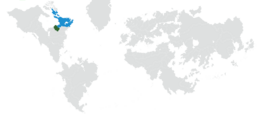Awasin: Difference between revisions
m (wip marker and historical divisions) |
m (template change i guess) |
||
| (2 intermediate revisions by the same user not shown) | |||
| Line 55: | Line 55: | ||
|government_type = {{wp|Federalism|Federated}} {{wp|Parliamentary|parliamentary}} {{wp|Elective monarchy|elective}} {{wp|Constitutional monarchy|semi-constitutional monarchy}} | |government_type = {{wp|Federalism|Federated}} {{wp|Parliamentary|parliamentary}} {{wp|Elective monarchy|elective}} {{wp|Constitutional monarchy|semi-constitutional monarchy}} | ||
|leader_title1 = Monarch | |leader_title1 = Monarch | ||
|leader_name1 = Waynoka | |leader_name1 = [[Waynoka Running Wolf|Waynoka]] | ||
|leader_title2 = Okina | |leader_title2 = Okina | ||
|leader_name2 = Machk Black Dog | |leader_name2 = [[Machk Black Dog]] | ||
<!--......--> | <!--......--> | ||
|leader_title14 = <!--(up to 14 distinct leaders may be included)--> | |leader_title14 = <!--(up to 14 distinct leaders may be included)--> | ||
| Line 204: | Line 204: | ||
===Sports=== | ===Sports=== | ||
{{Template:Ajax info pages}} | |||
[[category:Countries (Ajax)]] | [[category:Countries (Ajax)]] | ||
[[category:Countries]] | [[category:Countries]] | ||
Latest revision as of 03:56, 8 October 2023
This article is incomplete because it is pending further input from participants, or it is a work-in-progress by one author. Please comment on this article's talk page to share your input, comments and questions. Note: To contribute to this article, you may need to seek help from the author(s) of this page. |
Confederated Territories of Awasin ᐅᐦᑲᓇᐅᑕᐱ ᓯᓄᐟᐢᑐᐅ ᐊᐧᐊᐦᑭ ᐊᐊᐧᐦᓯᐢᑎᐃ (Awa'sipowa) Ohkanaotapi’sinotstoo waahki’Awahsistii ᐊᐢᑭᕀ ᑲᐦᐃᐠᔭᐤ ᐊᔨᐢᕀᓄᐊᐧᐠ (Evohone) Manhestotseo’ome notaxevehoneve’Vo’estanemasestse ᒪᐗᑦᓯᒪᐤ ᐊᐗᔅᔾ (Wazhewen) Mawaċimau Awasy | |
|---|---|
|
Flag | |
| Motto: "ᐅᐦᑲᓇ ᐃᓇᐊᓇᑐᐅ ᐃᐢᑕᐊᐦᐟ ᐊ'ᐱᐢᑐᑐᐅᑭ" "Ohkana'inaanatoo istaaht'A'pistotooki." "All things seen by the Creator." | |
| Anthem: ᐅᐦᑲᓇᐅᒧᐅᐧᐅ ᐅ'ᑭᐅ ᐊᐣᓄᐅᒪ Ohkanaomowoo o'kio'Annooma "Here Together" | |
 Location of Awasin on Earth. Other members of the North Osawanon Trade Agreement's customs union in blue. | |
| Capital | Nikanassin |
| Official languages | none at the federal level |
| Recognised national languages | |
| Demonym(s) | Awasi |
| Government | Federated parliamentary elective semi-constitutional monarchy |
• Monarch | Waynoka |
• Okina | Machk Black Dog |
| Legislature | Moyis'akaki |
| Sspi'moyis | |
| Ksi'moyis | |
| Area | |
• | 297,408 km2 (114,830 sq mi) |
| Population | |
• 2020 census | 5,130,452 |
• Density | 17/km2 (44.0/sq mi) |
| GDP (nominal) | 2020 estimate |
• Total | $68,235,011,600 |
• Per capita | $13,924 |
| Gini (2019) | 23.1 low |
| HDI (2019) | high |
| Currency | Awasi coda |
| Time zone | UTC -4 |
| Date format | dd/mm/yyyy |
| Driving side | right |
| Calling code | +52 |
| Internet TLD | .aw |
Awasin (insert pronunciation guide later IPAC), officially the Confederated Territories of Awasin, is a country in northeastern Norumbia. Its 6 provinces cover a landmass of approximately 297,408 square kilometers (114,829 square miles), bordered by Wazheganon to the north, Moxaney to the east, Chenes to the southeast and Mniohuta to the southwest. Most of Awasin's population of 5,130,452 live in or around the capital and largest city, Nikanassin, with the rest situated along the coast or in plains communities. Awasin is characterized by a majority indigenous population, with a small minority of other indigenous Norumbian groups and Mezhte.
Various indigenous peoples have inhabited the region since the previous ice age, remaining largely nomadic until increasing foreign pressure in the early 11th century prompted the establishment of settlements along the Omakatayo Mountains, the portion of the Winivere Cordillera located within modern Awasin. While contact with Belisarian, Ottonian, and other Norumbian influences were consistent from this point forward, the whole of the region was never subject to colonization or settlement by foreign powers, due in part to the area's geographic features as well as coordinated defenses by its inhabitants. Relations with Wazheganon solidified in the late 16th century during the Tyrrslandic conflicts, when Awasi tribes trained and supplied the indigenous Wazhe in equine combat. The status of indigenous Awasi in the Norumbian horse domain reached its greatest extent during the Asherionic Wars, the aftereffects of which would continue to heavily influence indigenous society.
Awasi politics and civil society in the mid-to-late 19th century continued to hold onto many Asherionic traditions, though agitation from Wazhe proto-socialist groups and advancing industrialization in neighboring nations prompted the region's many segmented tribes to consider the construction of a federal state. The pressure of Wazhe political uprisings in the 1860s, which would ultimately lead to the Wazhenaby Civil War, led to the formation of the First Awasi Confederation, later amended to include a Belisarian-inspired monarchical system replacing formalized shamanism as the Second Awasi Confederation. The modern state emerged as the Confederated Territories of Awasin in 1874.
Awasin is a federal parliamentary constitutional monarchy in the social corporate tradition, with an elected okina acting as the representative of the government and a nominally elected monarch acting as the civil and spiritual leader of the nation. The nation's legislature is bicameral, divided between the Sspi'moyis (upper house) and Ksi'moyis (lower house). Its mixed economy prioritizes private ownership, though many enterprises and publicly-listed firms are owned by the state. Agriculture is the largest industry, followed by gas extraction, oil refinement, and tourism. Awasin ranks highly in international evaluations of political freedom and involvement, government transparency, income equality, and overall quality of life. It is a member of the Osawanon Community and a founding member of the Norumbian People's Alliance, better known as Hahowin.

